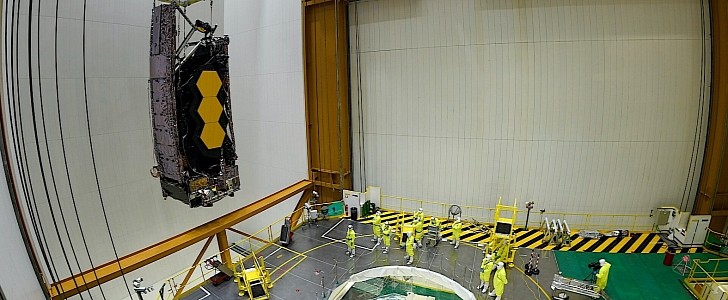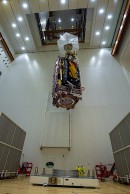Generally speaking, space exploration is a very resource-consuming affair. And by resources, we meant both the kind you can make some more of, like say cash, but also the kind one’s never going to get back, like time.
Ambitious space exploration programs take quite a lot of time, but few of them seem to have dragged out things as much as the James Webb Space Telescope (JWST) – work on the thing started all the way back in 1996, and the launch was initially scheduled for 2007.
That didn’t happen, of course, and here we are now, a quarter of a century later, finally getting ready to push the thing to its very distant orbit (almost one million miles away), from where it can look back in time to the early stages of the Universe. And one can only imagine how the people behind the project must feel now that, at last, the telescope has been paired to the rocket that will carry it beyond Earth’s pull, the European Ariane 5.
The event happened over the weekend, but it is only now that the European Space Agency (ESA) found time to share some details of the operation, including some images.
The fragile and very expensive telescope (NASA spent $10 billion over 25 years on it) had to be lifted 40 meters (131 feet) above ground to be positioned into the launch vehicle adapter and then on top of the rocket. The process went without problems.
Up next for the now rocket-telescope duo will be the encapsulation of the Webb into its fairing and then, obviously, the launch to space. This final step is expected to take place from the ESA spaceport in French Guiana on December 22.
After it leaves Earth, Webb will move to position itself at the so-called second Sun-Earth Lagrange point (L2), on the far side of Earth from the Sun. It will not orbit the Earth per se, but the star of our solar system.
Using its gigantic 6.5-meter (21.3-ft) diameter mirror, the telescope will be capable of peering into the light coming from the stars formed immediately after the Big Bang, in a bid to bring unravel some of the Universe’s deepest mysteries.
That didn’t happen, of course, and here we are now, a quarter of a century later, finally getting ready to push the thing to its very distant orbit (almost one million miles away), from where it can look back in time to the early stages of the Universe. And one can only imagine how the people behind the project must feel now that, at last, the telescope has been paired to the rocket that will carry it beyond Earth’s pull, the European Ariane 5.
The event happened over the weekend, but it is only now that the European Space Agency (ESA) found time to share some details of the operation, including some images.
The fragile and very expensive telescope (NASA spent $10 billion over 25 years on it) had to be lifted 40 meters (131 feet) above ground to be positioned into the launch vehicle adapter and then on top of the rocket. The process went without problems.
Up next for the now rocket-telescope duo will be the encapsulation of the Webb into its fairing and then, obviously, the launch to space. This final step is expected to take place from the ESA spaceport in French Guiana on December 22.
After it leaves Earth, Webb will move to position itself at the so-called second Sun-Earth Lagrange point (L2), on the far side of Earth from the Sun. It will not orbit the Earth per se, but the star of our solar system.
Using its gigantic 6.5-meter (21.3-ft) diameter mirror, the telescope will be capable of peering into the light coming from the stars formed immediately after the Big Bang, in a bid to bring unravel some of the Universe’s deepest mysteries.







